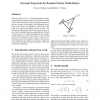Free Online Productivity Tools
i2Speak
i2Symbol
i2OCR
iTex2Img
iWeb2Print
iWeb2Shot
i2Type
iPdf2Split
iPdf2Merge
i2Bopomofo
i2Arabic
i2Style
i2Image
i2PDF
iLatex2Rtf
Sci2ools
ICRA
2002
IEEE
2002
IEEE
Extremal Trajectories for Bounded Velocity Mobile Robots
Previous work [3, 6, 9, 8, 7, 1] has presented the time optimal trajectories for three classes of non-holonomic mobile robots: steered cars that can only go forwards, steered cars that go forwards or backwards, and differential drives. Each of the vehicles is modelled as a rigid body in the plane with velocity and angular velocity controls. The systems are differentiated only by the bounds on the controls, but the optimal trajectories are qualitatively different for each system. We explore this difference by considering the effect that control bounds have on the extremal trajectories of bounded velocity vehicles, where the extremal trajectories are defined to be the set of trajectories that satisfy Pontryagin’s Maximum Principle, a necessary condition for optimality.
| Added | 15 Jul 2010 |
| Updated | 15 Jul 2010 |
| Type | Conference |
| Year | 2002 |
| Where | ICRA |
| Authors | Devin J. Balkcom, Matthew T. Mason |
Comments (0)

